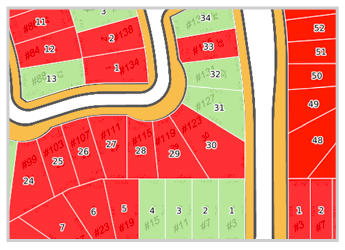You’ve chosen your community, your lot and your builder. Now you’re on to the most exciting part of your new home project—developing a floor plan and designing your home. All builders have a sales agent or design consultant who will be your guide through this process. It can seem overwhelming as there are many decisions to make, but it doesn’t have to be if you’ve done your research and have ideas of what you like.
Whether you are building a premium or custom home, your design consultant will be dedicating a lot of time to this step in the process, working with you to ensure all the details are right for your budget, lifestyle and vision for your new home.

You will most likely have determined this already, but as noted in the previous Choosing your builder article, lot selection can affect the cost of your home as well as the style of home that’s available to you. Some lots may require specific enhancements to meet the architectural guidelines that Qualico Communities has established for the neighbourhood; for example, if a house backs onto a wetland or public area, there may be specifications required for the deck, window trim, and exterior finishing.
Consider your lot plan and its impact on the design of your home; sun exposure, privacy, outdoor leisure space, curb appeal, and snow clearing are all things to keep in mind. If you haven’t selected your lot, you can work with your sales agent to choose from the lots that have been allocated to your selected builder keeping in mind your preferences but also your budget.
Are you building a premium or custom home? This will be driven by your choice of builder, budget and lot. Premium builders will recommend home plans from their design selection to best meet your lifestyle and budget. With custom designed homes, while you may start by reviewing existing plans to decide what you like, your home will be tailor-made for you.
Walking through show homes is a great way to get a sense of the floor plans your builder has previously built, as well as the quality and style of finishing in their homes.
Consider yours and your family’s daily routines. Think about your morning routines (do you need counter space for a toaster oven and coffee maker?), how you prepare and serve dinner (does your family cook together, or is there a lone home cook), are there personal spaces needed by you or other family members (for doing homework, having snacks, doing crafts, evening work, or playing games), and how you like to entertain the family as well as guests or business associates.
Know your measurements and requirements. When choosing from an existing plan, look at the room size alongside the measurements of the furniture you plan to put into the new home, how it might be placed, traffic patterns, position of lighting, windows and of course how you plan to use each room in the house. Your homebuilder may have 3D planning software to help you in this and other areas of designing your home. Another consideration for many homeowners is space for running home-based businesses and client meetings.
Philip Musick, a sales agent with Broadview and Sterling Homes said that the builder’s floor plans generally reflect the diverse demographics of homebuyers. “It’s much like having different models of cars. Different “models” or plans meet different needs of the marketplace.”
Because you’re building a new home, you will have a say in all of the details but there are some decisions that need to be made sooner than others to finalize your plans and purchase agreement. Your sales agent will walk you through these early decisions, which may include choices such as construction materials, mechanical, electrical and plumbing systems that need to be determined at the start of the project. During the build, you will continue to work with the builder and their in-house designers in selecting the design elements and finishes that will go into your home.
The builders’ sales agents are knowledgeable in all aspects of the available floor plans as well as the architectural guidelines for the community. It’s their responsibility to guide you through the process for getting your plan through to final approval, and supporting you throughout the build and as you take final possession of your new home.
Qualico Communities provides final approval to your builder of your exterior plans. This is to ensure that the design of homes within our communities support the cohesiveness Qualico works hard to achieve, as well as to protect the property values for all homeowners. Changes may be requested, which your builder will have you review before they send the plans back to Qualico Communities for final sign-off. Once the plans are approved, you’re off to the races and will continue to work directly with your sales agent and builder.
There may also be some landscaping requirements, which you’ll want to consider in the design as well as the purchase price of your home. Know what you are required to do as part of your agreement with the builder, if you’ll be required to give your builder a landscaping deposit, and the conditions under which your deposit will be returned. While it can vary, your contract with your builder will likely include holding your deposit until requirements such as sodding and landscaping (in most cases the front yard within the first year) are met.
Have fun with your features and finishes
Your trusted sales agent will lead you through this process—from choosing what kind of finish you want on the exterior of your home to the choice of interior finishing including flooring, countertops, fixtures, lighting, paint colour and the list goes on and on.
Michelle Gosselin of the Qualico Design Centre shares that different builders approach design support in different ways. That may include attending open houses where the multitude of finishes are available to buyers or working one-on-one with in-house designers. Tips she offers are bringing in cushions, fabric swatches and measurements of key pieces of furniture that will be going into the new home.
Gosselin urges new homebuyers to think about their own routines and how the home can be designed to best fit a variety of needs. “You want to make the home work for you on a daily basis, not just that ‘wow’ when you first walk in the door.”
What are some of the major design decisions that the buyer will want to make first? Gosselin suggests starting in the kitchen. This, she said is because it’s best to start with the appliances and design around choices that may include gas or electrical fittings. “You can always refine the kitchen layout but fittings for electrical or gas appliances, and plumbing have to be roughed in early and you don’t want to be changing this later on.”
Fireplaces have also become another design decision offering a myriad of choices – which again, should be made very early. Same with other structural choices that can affect design.
Is it included or extra?
Just as there are many choices in designing your home, standard home design features can vary widely from builder to builder.
Liam Milne of Hearth Homes says that asking for “base price” is especially tricky because the homebuyer has no idea what that includes and what upgrades will cost. He agrees that the best approach is for customers to talk to their sales agent to again identify their lifestyle needs and go from there. “There are certain items when building a home you want to do initially or you never will.” Others can be done later on. “The new homes are super-efficient so people can manage without air conditioning initially,” he said. “An insulated basement is also standard (in a Hearth Home) but finishing it isn’t and if the home owner doesn’t plan to ever use it, they’ve just saved a whole lot of money.”
Milne stresses asking the questions and working through your sales agent to arrive at these decisions so that you can put your money into the features of your home that are the most important to you.
What’s Next?
Now that you know more about the steps for designing your new home, watch for our next during the build. If you’re looking for more information about a particular builder, home plans or lots, visit the Qualico Communities website or call 204.254.9225.

